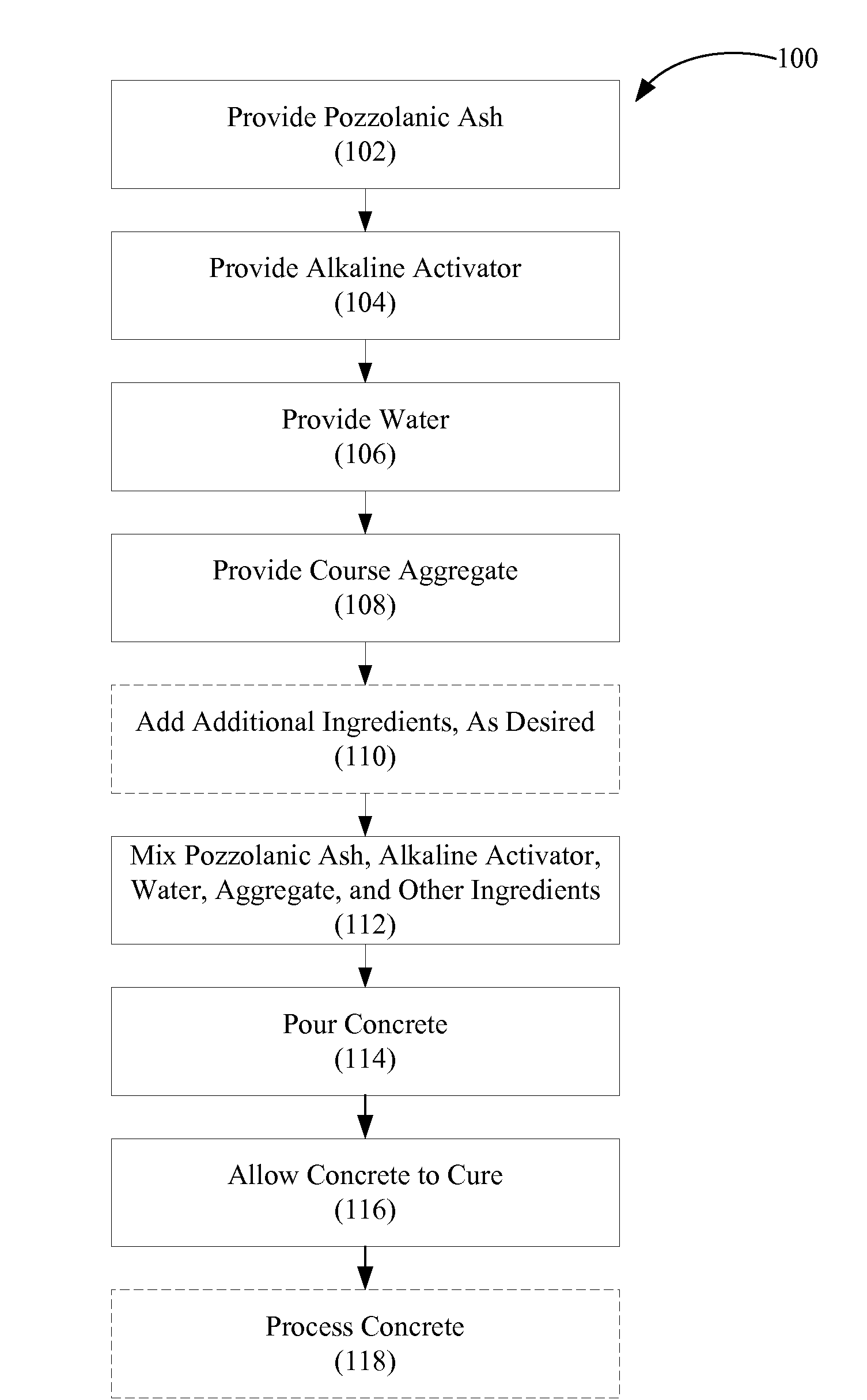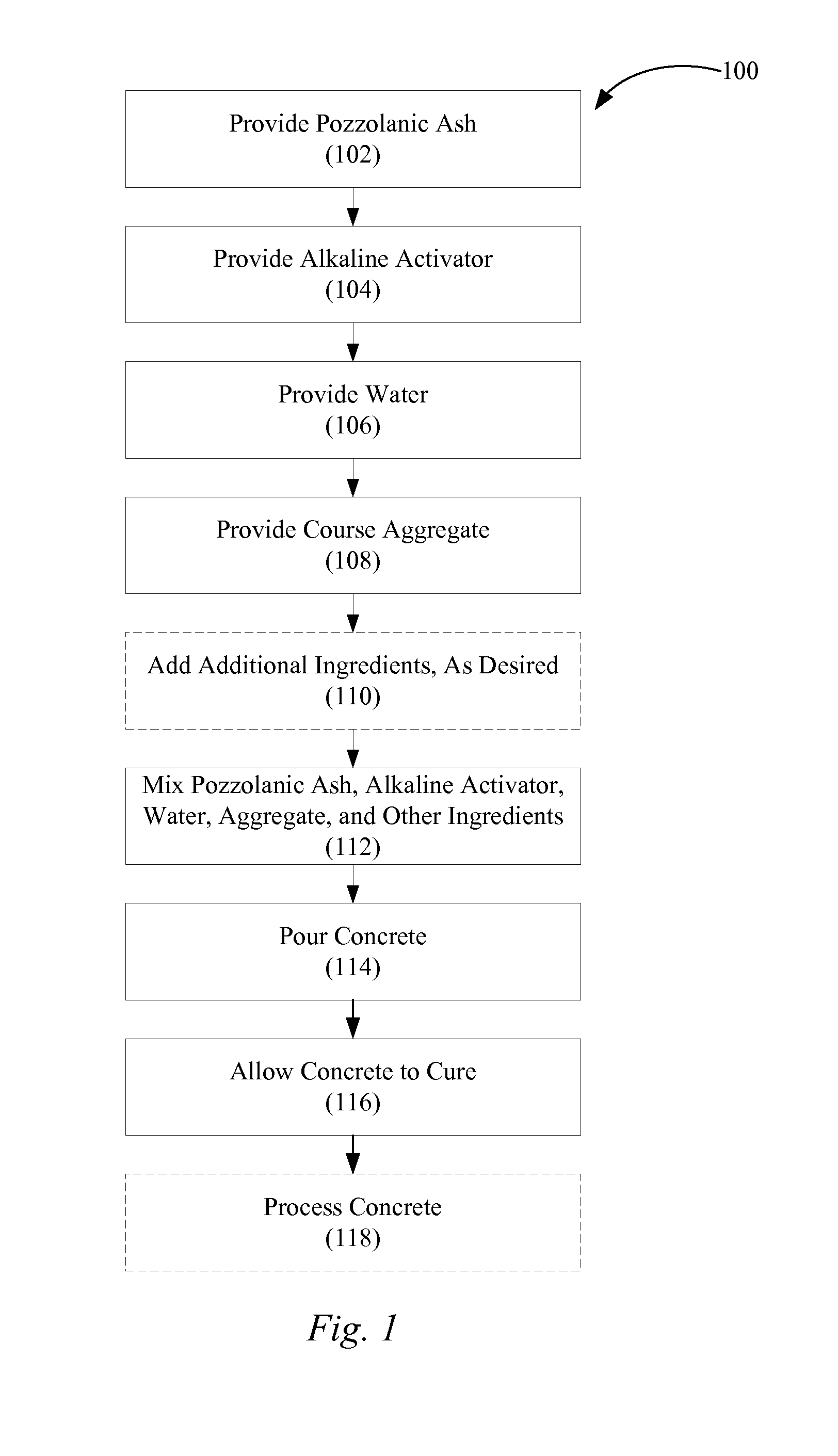Previous concrete comprising a geopolymerized pozzolanic ash binder
a geopolymerized pozzolanic ash and concrete technology, applied in the field of concrete, can solve the problems of inability to replenish the water table, less availability, limited amount of fly ash that can be used in concrete, etc., and achieve the effects of superior performance, less maintenance cost, and durable concr
- Summary
- Abstract
- Description
- Claims
- Application Information
AI Technical Summary
Benefits of technology
Problems solved by technology
Method used
Image
Examples
example 1
[0059]
TABLE 3Compression Test Results of Various Non-geopolymerized ConcreteSamples.SampleCompression TestNameRatio of Portland Cement (PC) to Fly AshResults in (MPa)Sample A1:0 (e.g., 100% PC)~24Sample B2.33:1 (e.g., 70% PC and 30% Fly Ash)~38Sample C1:1 (e.g., 50% PC and 50% Fly Ash)~33Sample D0:1 (e.g., 100% Fly Ash)~0.2Sample E0:1 (e.g., 100% Geopolymerized Fly Ash)~20
[0060]In a first hypothetical example, Table 3 shows that 5 samples of 50 mm concrete cubes comprising different concentrations of Portland cement and / or a fly ash are made by mixing the Portland cement, sand, and / or fly ash together with water and a conventional plasticizer. Standard mortar casting procedures are used. Each mixture is thoroughly mixed for 5 minutes, cast into the 50 mm cube molds, and then be allowed to cure for 7 days in a lime water solution. It is important to note that in this example, the Samples A through D would are cured, but the pozzolanic ash in the samples would not be geopolymerized.
[0...
example 2
[0063]In a second example, 50 mm concrete cubes of samples comprising Portland cement and bark ash at a ratio of about 2.33 parts Portland cement for about every 1 part of bark ash are prepared. The bark ash is mixed with Portland cement, sand, water, and a plasticizer. The bark ash is then geopolymerized. Table 4 provides four different bark ash samples with possible surface area sizes and particle size ranges that could be obtained from testing the samples.
TABLE 4Characteristics of Geopolymerized Bark-ash-containing Cement SamplesSamplePossible SurfacePossible ParticleNameActivator SolutionArea (m2 / g) rangesSize (μm) rangesMS-DCNa2CO3 + NaOH25-50210-250MS-BHNa2CO3 + NaOH40-70 5-25W-DCNa2CO3 + NaOH30-4540-70W-PrecipNa2CO3 + NaOH100-120100-120
[0064]It is anticipated that compression testing of the 4 bark ash samples in Table 4 could show that the 4 samples in that table have compressive strengths that range from about 1 MPa to about 20 MPa and possibly higher depending on the sample...
PUM
| Property | Measurement | Unit |
|---|---|---|
| diameter | aaaaa | aaaaa |
| compressive strength | aaaaa | aaaaa |
| compressive strengths | aaaaa | aaaaa |
Abstract
Description
Claims
Application Information
 Login to View More
Login to View More - R&D
- Intellectual Property
- Life Sciences
- Materials
- Tech Scout
- Unparalleled Data Quality
- Higher Quality Content
- 60% Fewer Hallucinations
Browse by: Latest US Patents, China's latest patents, Technical Efficacy Thesaurus, Application Domain, Technology Topic, Popular Technical Reports.
© 2025 PatSnap. All rights reserved.Legal|Privacy policy|Modern Slavery Act Transparency Statement|Sitemap|About US| Contact US: help@patsnap.com


